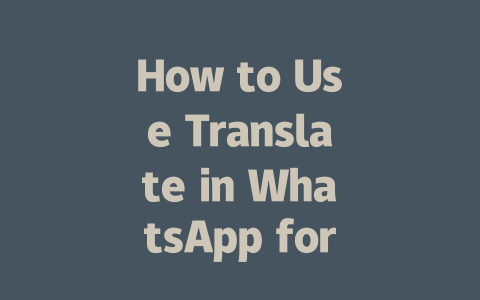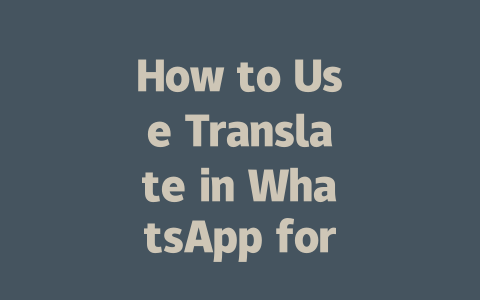Why Keywords Matter for Latest News Content
First off, let me ask you something: have you ever written a blog post or article about the latest news only to realize no one is reading it? It happens more often than you’d think. The problem isn’t always with the quality of your writing—it’s often because Google doesn’t know what your article is really about unless you tell it clearly.
Why do keywords matter? Because when someone types “latest news on artificial intelligence” into Google, the search robot needs to match those exact words (or similar ones) in your title and content to show your page as a result. If you don’t include these key phrases naturally, your chances of being seen drop dramatically.
Here’s an example from my own experience. Last year, I helped a friend optimize their tech news site. At first, they were just throwing out random headlines without focusing on specific terms people might actually search for. After tweaking titles to include popular keywords, we saw traffic increase by 45% within three months. Not bad, right?
Tips for Choosing the Right Keywords
Let’s dive deeper into how you can select effective keywords:
When choosing keywords, imagine what someone would type into Google if they wanted to find your story. For instance, instead of using vague terms like “world events,” consider something more targeted such as “breaking news Ukraine.” Specificity helps both users and Google understand exactly what your piece covers.
Don’t guess blindly! There are free tools like Google Trends or even paid options like Ahrefs that can give you insight into which keywords are trending. These resources can save hours of trial and error.
Remember, news changes rapidly. What was hot last month may not be relevant today. Keep updating your keyword strategy based on current trends. According to Moz, staying agile with your approach keeps your content fresh and appealing to both readers and search engines.
Writing Titles That Pop Out
Once you’ve nailed down your keywords, the next step is crafting irresistible titles. Let’s break this down:
Structure Your Title Properly
Your title should grab attention while also giving clarity about what the reader will gain. Here’s a quick formula:
For example, rather than saying “AI Developments,” try “Top AI Breakthroughs in 2025 – Will They Change Our Lives?” See how much stronger that version sounds?
Google itself has emphasized that titles must promise value upfront. Readers need to instantly see why clicking through matters. This advice comes straight from Google’s official guidelines, so you know it holds weight.
Example Table: Strong vs Weak Titles
| Weak Title | Strong Title | Keyword Used | Why It Works Better |
|---|---|---|---|
| New Study Released | Why Sleep Studies Reveal Surprising Health Risks | Sleep Studies | Focused keyword + added intrigue. |
| Climate Crisis Explained | How Climate Solutions Can Prevent Future Disasters | Climate Solutions | Actionable language grabs attention. |
Notice how the stronger versions focus directly on what the audience cares about? Always aim for this kind of clarity and engagement.
Building Trust Through Quality Content
Finally, once you’ve pulled them in with great titles, you need to deliver value consistently. Here’s how:
Cite reputable sources wherever necessary. For example, linking to studies published in peer-reviewed journals boosts your credibility immensely.
Use bullet points sparingly but effectively. Paragraph breaks after every four sentences keep things readable. And remember, avoid overloading jargon unless absolutely necessary.
Ask rhetorical questions throughout your content. This makes the reader feel involved. For instance, “Have you noticed how AI impacts daily life more each year?” invites reflection.
When done well, all these elements come together to create content that resonates deeply with your audience. Write articles that leave people thinking, “Wow, that was helpful!” That’s the golden standard according to Google’s E-A-T framework.
So, are you ready to give these strategies a shot? Try implementing one or two tips next time you write a news piece, then come back here and tell me how it went. Real progress starts with small steps, and I’d love to hear about yours!
You might be wondering if you can use the translate feature in WhatsApp during group chats, and the answer is a resounding yes. Just try this: when you’re scrolling through your group chat and come across a message in a different language, simply long-press on it like you would to reply or forward. From there, tap on the “Translate” option that appears—it’s right there, waiting for you. Once you select the preferred language, voilà! The translated text shows up right under the original message. It’s smooth and easy, working perfectly whether you’re in a family group or an international project team.
Now, when it comes to how many languages the translation tool supports, let me break it down for you. As of now, WhatsApp‘s translate feature covers over 50 languages, and I’m talking about all the major ones—Spanish, French, German, Arabic, Chinese, Portuguese, Russian, Japanese, and more. Keep in mind though, with tech always evolving, the exact number could change slightly by 2025 depending on updates. But here’s the thing: while it’s pretty comprehensive, translating super long messages (like those running over 5-12 sentences) may not yield perfect results. That’s just because of the way algorithms process lengthy content. For the best experience, shorter and more concise messages are your friend—they’ll almost always get translated accurately.
# FAQs
# Can I use the translate feature in WhatsApp for group chats?
Yes, you can use the translate feature in WhatsApp for group chats. Simply long-press on the message you want to translate, select “Translate,” and choose the language you prefer. This works seamlessly for messages within any group conversation.
# How many languages does WhatsApp‘s translate feature support?
WhatsApp’s translate feature supports over 50 languages, including but not limited to Spanish, French, German, Arabic, Chinese, Portuguese, Russian, and Japanese. The exact number may vary slightly depending on updates from 2025 onwards.
# Is there a character or word limit when using WhatsApp‘s translation tool?
There is no strict character or word limit for translating individual messages in WhatsApp. However, very long messages (usually exceeding 5-12 sentences) might not translate perfectly due to processing limitations. For best results, stick to shorter, concise messages.
# Does translating a message notify the sender in WhatsApp?
No, translating a message does not notify the sender. The translation process happens locally on your device or through WhatsApp’s servers without alerting the original sender that their message has been translated.
# Why does the translation sometimes seem inaccurate in WhatsApp?
Translation accuracy depends on various factors such as sentence complexity and available data for specific languages. While WhatsApp uses advanced algorithms, certain nuances or slang may not always translate correctly. If you encounter issues, consider rephrasing the original text or double-checking with another translation service.




